Origami offers a serene path to stress relief and enhanced focus. You'll find tranquility in simple techniques like folding paper cranes, boats, and lotus flowers. For mindfulness, try creating origami hearts while practicing deep breathing. Explore calming geometric patterns or assemble modular stars for a structured approach. Craft peaceful windmills or shape serene animal figures to engage your creativity. Advanced practitioners can immerse themselves in complex kusudamas for deeper concentration. Each fold brings you closer to a state of calm, improving fine motor skills and promoting relaxation. These ten techniques are just the beginning of your journey into the meditative world of paper folding.
Simple Paper Crane Folding
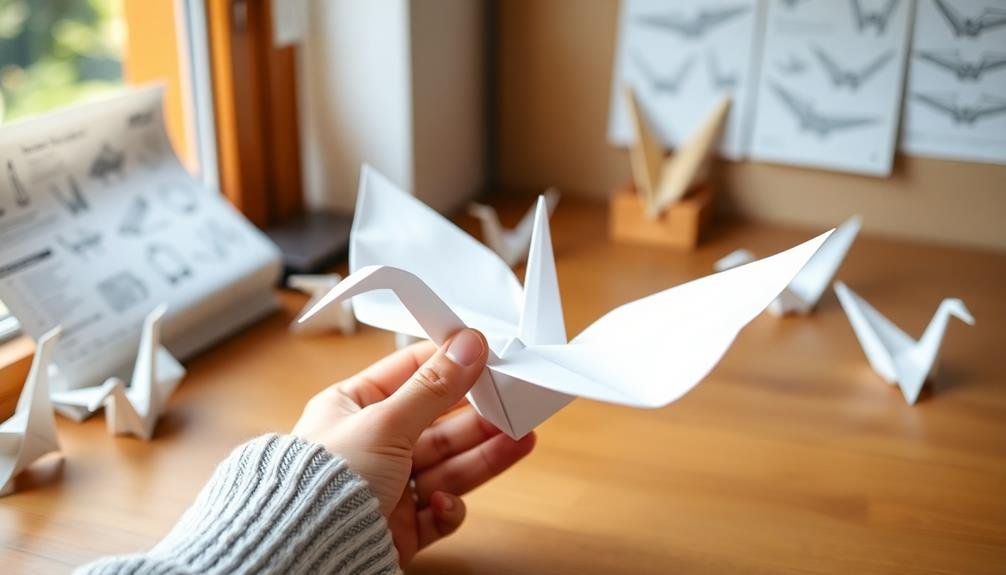
Every journey into origami begins with a single fold, and the paper crane is an ideal starting point. This classic design combines simplicity with elegance, making it perfect for beginners and a great stress-reliever.
To start, you'll need a square sheet of paper. Begin by folding it in half diagonally, then unfold and repeat in the other direction. Next, fold the paper in half horizontally and vertically, creating creases.
Open the paper and fold it into a smaller square by bringing the corners to the center.
Now, lift the top edges to the center crease, forming a kite shape. Fold the narrow points inward to create the crane's head and tail.
For the wings, fold the sides into the center, then fold the entire model in half lengthwise.
Meditative Box Creation
You'll find creating a meditative origami box to be a soothing experience.
Start with a square sheet of paper and follow the step-by-step folding process, which involves precise creases and repetitive actions.
As you fold, you'll notice your mind focusing solely on the task at hand, allowing worries to fade away and promoting a sense of calm and mindfulness.
Step-By-Step Folding Process
Creating a meditative origami box offers a soothing journey into mindfulness. Begin with a square sheet of paper, preferably in a color that calms you. Fold the paper in half diagonally, then unfold and repeat in the opposite direction. You'll see creases forming an X.
Next, fold each corner to the center point where the creases intersect. You'll now have a smaller square.
Turn the paper over and repeat the previous step, folding each corner to the center. This creates the base of your box.
For the lid, start with a slightly larger square and follow the same steps. To form the box's sides, carefully lift each corner and fold it towards the center, creasing along the existing folds.
As you work, focus on your breath and the sensations in your fingers. Feel the paper's texture and listen to the soft sounds of folding. This mindful attention helps quiet your mind and reduces stress.
Once complete, you'll have a beautiful box and a calmer state of mind. Practice this technique regularly to enhance your focus and relaxation skills.
Benefits of Repetitive Folding
Repetitive folding in origami offers numerous benefits for stress relief and mental well-being. As you create a meditative box, you'll find yourself entering a state of flow, where your mind focuses solely on the task at hand. This concentration helps to quiet racing thoughts and reduce anxiety.
The rhythmic nature of folding paper can lower your heart rate and blood pressure, promoting a sense of calm. You'll notice your breathing becoming slower and more controlled as you immerse yourself in the process. This meditative state can improve your overall mood and increase feelings of relaxation.
Engaging in repetitive folding also enhances your fine motor skills and hand-eye coordination. You'll develop patience and persistence as you work through each step, building confidence in your abilities. The tactile experience of handling paper can be grounding, helping you stay present in the moment.
Moreover, the satisfaction of completing a meditative box provides a sense of accomplishment. You'll have created something tangible, which can boost your self-esteem and provide a positive distraction from stressors.
Calming Lotus Flower Technique
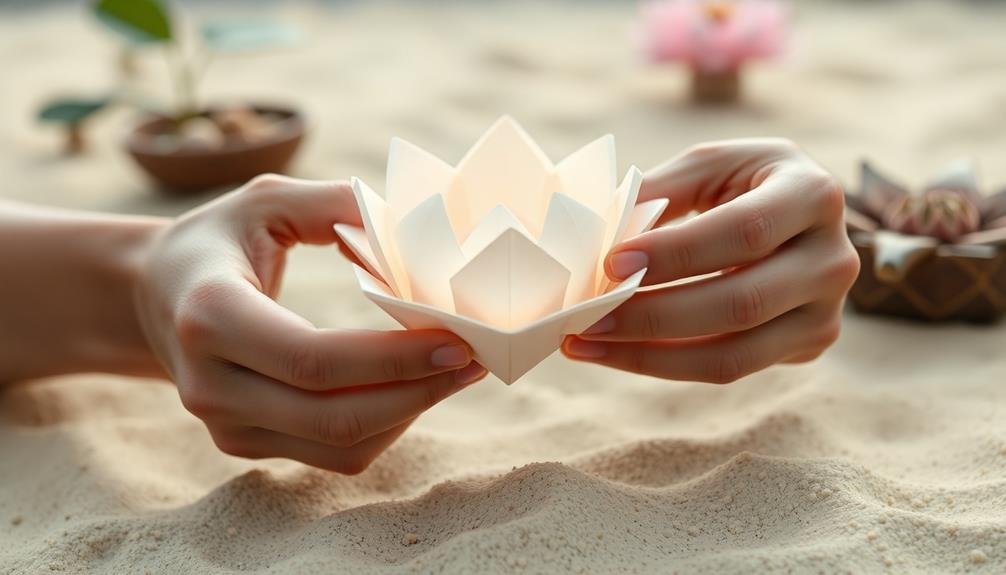
You'll find peace in creating a lotus flower through origami's precise folds.
The step-by-step process guides your hands, allowing your mind to focus solely on each crease and turn.
As you repeat the folding motions, you'll naturally enter a meditative state, letting stress melt away with each petal formed.
Step-By-Step Folding Instructions
To begin the calming lotus flower origami, you'll need a square sheet of paper and a flat surface. Position the paper color-side down, with a corner pointing towards you. Fold the paper in half diagonally, then unfold. Repeat this fold in the opposite direction, creating an X crease.
Next, fold each corner to the center point where the creases intersect. You'll now have a smaller square. Flip the paper over and repeat this step, folding all four corners to the center. Turn the paper over again.
Now, fold each corner to the center once more. You'll see eight triangular flaps. Carefully lift each flap, folding it back on itself to create petals. As you do this, the lotus will begin to take shape.
To refine the flower, gently curve each petal outward, giving it a more natural appearance. Adjust the petals as needed, ensuring they're evenly spaced. For a final touch, you can slightly curl the tips of the petals using your fingernail.
This process not only creates a beautiful lotus flower but also encourages mindfulness and focus, helping to alleviate stress as you immerse yourself in the intricate folds.
Mindfulness Through Repetition
Throughout the process of creating the calming lotus flower, you'll find that the repetitive nature of folding serves as a powerful tool for mindfulness. As you repeat each fold, your focus narrows, drawing your attention away from daily stressors and into the present moment. This repetition allows your mind to enter a meditative state, promoting relaxation and mental clarity.
To enhance mindfulness while crafting your lotus flower:
- Focus on your breath, syncing each inhale and exhale with your folding movements.
- Notice the texture of the paper beneath your fingertips, appreciating its smoothness or texture.
- Observe the gradual transformation of the flat sheet into a three-dimensional form.
- Pay attention to the precise creases and angles, ensuring each fold is deliberate and mindful.
As you progress through the lotus flower's creation, you'll notice your thoughts becoming less scattered and more centered. The repetitive actions serve as an anchor, grounding you in the present moment.
This mindfulness practice not only results in a beautiful origami creation but also cultivates a sense of calm and focus that can extend beyond your crafting session.
Mindful Origami Heart Exercise
The Mindful Origami Heart Exercise offers a soothing blend of paper folding and mindfulness techniques.
Begin by selecting a square sheet of paper in a color that resonates with you. As you hold the paper, take a deep breath and focus on its texture and weight in your hands. Fold the paper diagonally, creasing it firmly while exhaling slowly. Unfold and repeat in the other direction, maintaining awareness of your breath and the sensations in your fingertips.
Continue folding the heart shape, pausing between each step to observe your thoughts and emotions. Notice any tension in your body and consciously relax those areas.
As you create the final folds, imagine infusing the heart with positive energy or a specific intention. Once complete, hold the origami heart in your palms and reflect on the journey of its creation.
This exercise not only produces a tangible symbol of care but also encourages present-moment awareness. By combining the meditative aspects of origami with intentional breathing and reflection, you'll cultivate a sense of calm and focus.
Practice this mindful origami heart technique whenever you need a moment of tranquility in your day.
Peaceful Paper Boat Crafting

With a gentle ripple of calm, Peaceful Paper Boat Crafting offers a serene journey into origami-based stress relief. This simple yet engaging technique allows you to create a miniature flotilla of tranquility, right at your fingertips.
As you fold each crease, you'll find your mind drifting away from daily stressors, focusing instead on the methodical process of boat creation.
To begin your peaceful paper boat crafting session, follow these steps:
- Choose a square sheet of paper, preferably in a calming color like blue or green
- Fold the paper diagonally, then unfold and repeat in the other direction
- Bring the top edges to the center crease, creating a triangle shape
- Fold the bottom corners up to meet the top edge, then tuck them inside the pocket
As you craft your paper boat, pay attention to the texture of the paper and the precise movements of your hands. This mindful approach enhances the stress-relieving benefits of the activity.
Once complete, you can float your creation in a bowl of water or display it as a reminder of your moment of peace.
Relaxing Butterfly Formation Process
You'll find tranquility in creating an origami butterfly through our step-by-step folding guide.
As you select colors for your creation, consider how different hues can influence your mood and enhance the calming experience.
While forming your butterfly, reflect on its symbolism of transformation and renewal, allowing these concepts to resonate with your own journey towards stress relief.
Step-By-Step Folding Guide
Gentle folds and precise creases come together to form a delicate butterfly, offering a serene escape from daily stressors. As you initiate this origami journey, you'll find each step brings you closer to a state of calm focus.
Begin with a square sheet of paper, preferably in a soothing color that resonates with you.
Follow these steps to create your stress-relieving butterfly:
- Fold the paper diagonally in both directions, then unfold. Next, fold in half horizontally and vertically, unfolding after each.
- Lift the top edge to the center crease, forming a small triangle. Repeat on the bottom edge.
- Fold the left and right corners inward to meet at the center line, creating wing shapes.
- Gently curve the wings upward, adjusting until you're satisfied with the butterfly's form.
As you progress through each fold, concentrate on the tactile sensation of the paper and the precision of your movements.
This mindful practice encourages you to stay present, pushing away intrusive thoughts and allowing stress to melt away. Remember, the process is just as important as the final product in achieving relaxation.
Mindful Color Selection
Colors play an essential role in the stress-relieving benefits of origami. When choosing paper for your relaxing butterfly formation, consider hues that evoke calm and tranquility. Cool colors like blues and greens are known to reduce anxiety and promote relaxation. Warm tones such as soft yellows and light pinks can uplift your mood and inspire creativity.
As you select your paper, take a moment to breathe deeply and connect with each color. Notice how different shades make you feel. This mindful approach enhances the meditative aspect of origami. Here's a guide to help you choose colors based on the emotions you want to cultivate:
| Color | Emotion | Color | Emotion |
|---|---|---|---|
| Blue | Serenity | Green | Balance |
| Lavender | Calmness | Yellow | Optimism |
| Pink | Compassion | White | Clarity |
| Purple | Creativity | Orange | Energy |
Don't be afraid to experiment with color combinations. You might find that pairing contrasting colors or creating gradients adds an extra layer of engagement to your origami practice. Remember, the goal is to choose colors that resonate with you and enhance your relaxation experience.
Butterfly Symbolism Exploration
As you begin folding your chosen paper into the relaxing butterfly shape, it's worth considering the rich symbolism associated with these delicate creatures. Butterflies have long been a source of inspiration and meaning across cultures, representing transformation, hope, and new beginnings.
As you create each fold, reflect on how these symbols might apply to your own life and current situation.
The butterfly's metamorphosis journey can be a powerful metaphor for personal growth and change. Consider these aspects as you craft your origami butterfly:
- Chrysalis stage: Embrace periods of rest and self-reflection
- Emergence: Celebrate breakthroughs and personal achievements
- Flight: Envision your goals and aspirations taking wing
- Beauty: Appreciate your unique qualities and strengths
Soothing Modular Star Assembly
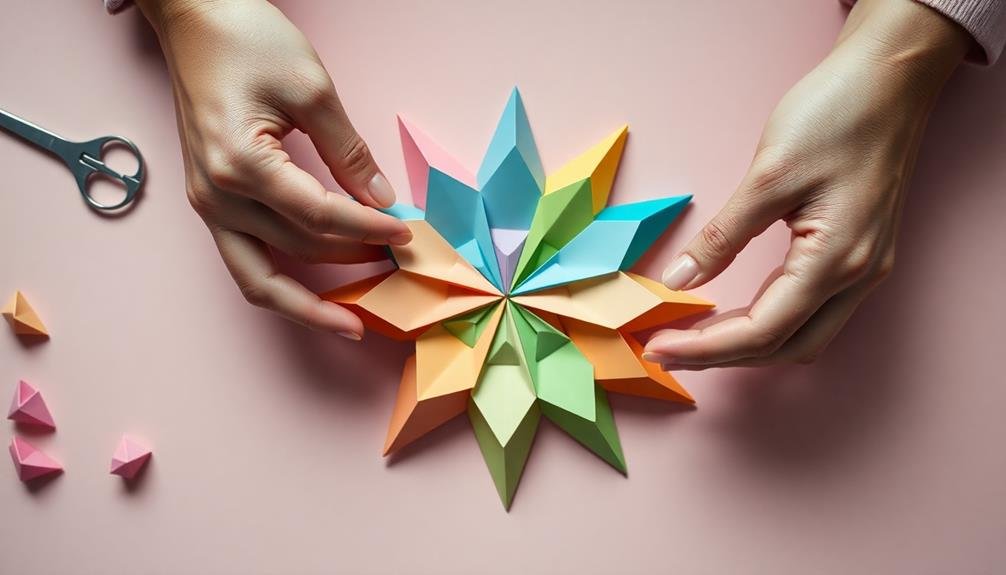
The intricate dance of paper folding reaches its zenith with the Soothing Modular Star Assembly. This enchanting project combines precision and repetition to create a stunning three-dimensional star. You'll find yourself lost in the meditative process as you fold multiple identical units, each one a step towards the final masterpiece.
Begin by selecting six to eight square sheets of paper in complementary colors. Fold each sheet into a simple module, typically involving diagonal folds and pocket formations. As you create each unit, focus on the crisp edges and symmetry, letting the repetitive motions calm your mind.
Once you've prepared all the modules, it's time for assembly. Slide the units together, interlocking them to form the star's points. You'll feel a sense of accomplishment as the shape takes form before your eyes.
The process requires patience and attention to detail, naturally shifting your focus away from daily stressors. As you complete your modular star, take a moment to admire its geometric beauty. This project not only serves as a stress-relieving activity but also results in an impressive decoration for your space.
Tranquil Paper Windmill Construction
Moving from stars to spinning wonders, we'll now explore the Tranquil Paper Windmill Construction. This elegant and soothing origami project offers a delightful way to unwind and focus your mind. As you fold and shape the paper, you'll find your stress melting away with each precise crease.
To create your own tranquil paper windmill, follow these steps:
- Begin with a square sheet of origami paper, color side down.
- Fold the paper diagonally in both directions, then unfold.
- Fold each corner to the center point, creating a smaller square.
- Fold the resulting square in half diagonally, then unfold.
As you work through these initial folds, concentrate on the tactile sensation of the paper and the precision of your movements. The repetitive nature of folding can induce a meditative state, helping you achieve inner calm.
Once you've completed the base, you'll create the windmill's blades by making strategic cuts and folds. As you assemble the final structure, you'll experience a sense of accomplishment and tranquility.
The finished windmill serves as a beautiful reminder of your ability to create order and beauty from simplicity.
Serene Animal Figure Shaping
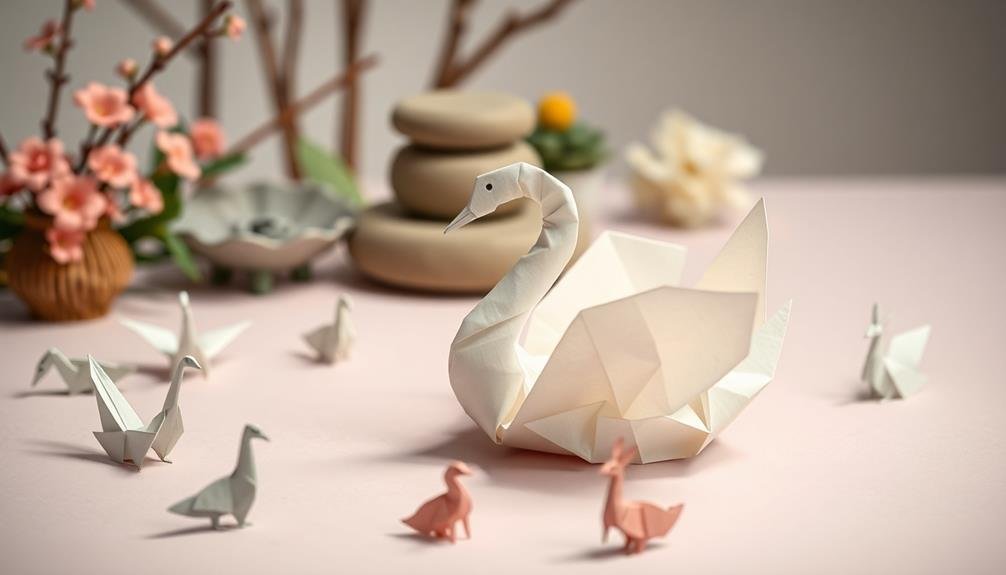
From delicate windmills to graceful creatures, serene animal figure shaping offers another calming avenue for origami enthusiasts. You'll find that creating animal figures can be both meditative and rewarding. Start with simple designs like cranes or rabbits, gradually progressing to more complex creatures as your skills improve.
Focus on smooth, deliberate folds as you bring your paper animal to life. Pay attention to the crisp lines and angles that form each creature's unique shape. As you work, you'll notice your mind becoming absorbed in the task, pushing away stressful thoughts and promoting a sense of tranquility.
Try folding a variety of animals to discover which ones resonate with you most. Perhaps you'll find peace in the elegant curves of a swan or the playful ears of a fox. Remember, the goal isn't perfection but rather the journey of creation and the calm it brings.
To enhance your experience, choose paper with soothing colors or patterns that complement the animal you're creating. This thoughtful selection can further amplify the stress-relieving effects of your origami practice.
Zen-Inspired Geometric Pattern Folding
Zen-inspired geometric pattern folding offers a structured approach to origami that can be particularly soothing for those who find comfort in repetition and symmetry.
This technique involves creating intricate designs through precise folds, often resulting in stunning 3D shapes. You'll find that focusing on the mathematical aspects of these patterns can help quiet your mind and reduce stress.
To get started with Zen-inspired geometric origami, you'll need:
- High-quality origami paper
- A flat, clean surface
- Patience and concentration
- Basic knowledge of origami symbols and folds
As you practice, you'll notice your attention shifting away from daily worries and onto the task at hand.
The repetitive nature of folding complex geometric patterns can induce a meditative state, promoting relaxation and mindfulness. You might start with simple tessellations and gradually move on to more challenging designs like modulars or kusudamas.
Frequently Asked Questions
Can Origami Help Improve Hand-Eye Coordination and Fine Motor Skills?
Yes, origami can definitely boost your hand-eye coordination and fine motor skills. As you fold and manipulate paper, you're constantly using your fingers and eyes together, improving precision and dexterity. It's a great way to enhance these abilities.
Are There Any Origami Techniques Specifically Designed for Children or Beginners?
Yes, there are origami techniques for children and beginners. You'll find simple models like paper airplanes, boats, and animals. Start with basic folds and progress to more complex designs as you improve. It's a fun, engaging hobby for all ages.
How Can Origami Be Incorporated Into a Daily Mindfulness or Meditation Practice?
You can incorporate origami into your daily mindfulness practice by setting aside time to fold simple shapes. Focus on your breath and the paper's texture as you create. It's a meditative process that calms your mind and enhances concentration.
What Are the Best Types of Paper for Different Origami Techniques?
You'll want to choose your paper wisely. For simple folds, standard origami paper works well. For complex designs, try thin, crisp washi. Wet-folding techniques need thicker, absorbent paper. Don't forget to contemplate color and pattern too.
Can Origami Be Used as a Form of Art Therapy?
Yes, you can use origami as art therapy. It's a calming, meditative practice that enhances focus and creativity. You'll find it helps reduce stress, improves mood, and boosts self-esteem. It's also great for developing fine motor skills.
In Summary
You've now explored ten origami techniques that can help you find calm and focus. As you practice these folds, you'll notice your stress melting away and your concentration improving. Remember, it's not about perfection but the journey of creation. Whether you're folding cranes or crafting geometric patterns, origami offers a mindful escape from daily pressures. So pick up some paper, let your fingers guide you, and discover the meditative power of this ancient art form.

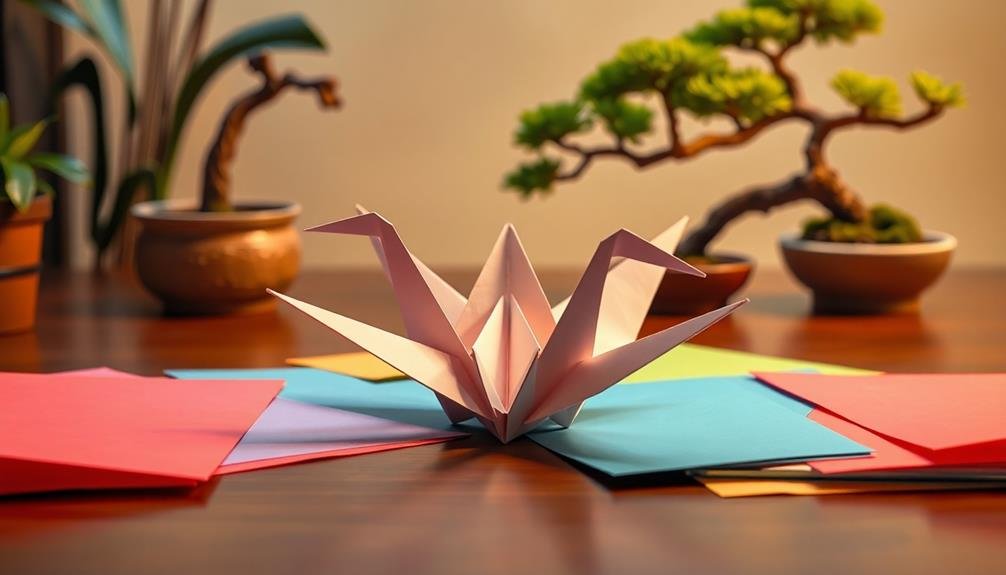



Leave a Reply